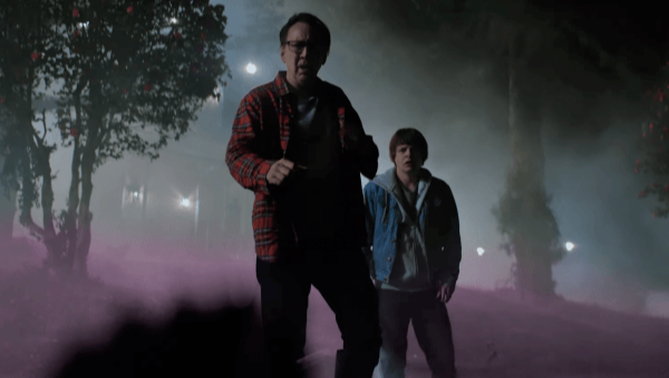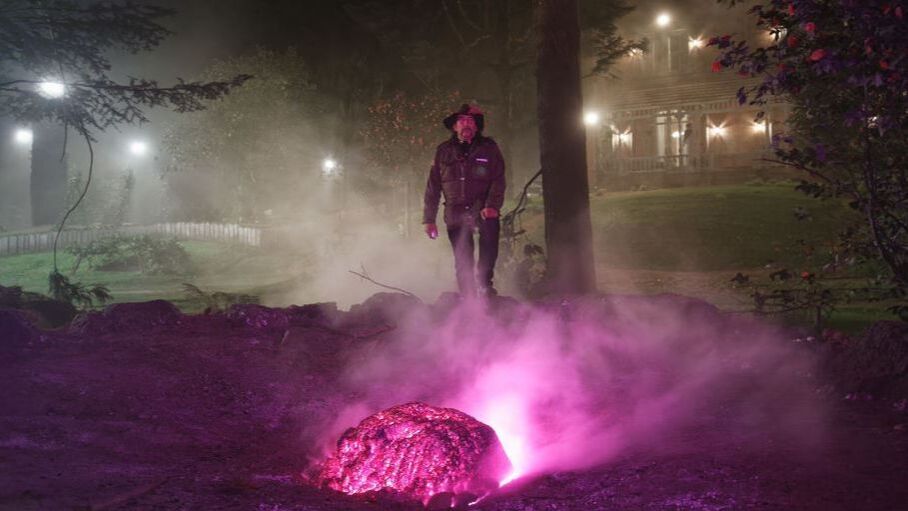 The name H.P. Lovecraft usually conjures up images of magnificent, tentacled beasts, but such nightmares are not all the notorious author has to offer... ...Color Out of Space received a limited release one year ago this month, and it delivered an otherworldly being without tentacles. Or any body parts, for that matter. Color plays like a cinematic, acid-fueled love letter to Lovecraftian cosmic horror. Eccentric director Richard Stanley returns to filmmaking after two decades to direct the first of a planned trilogy of films based on Lovecraft’s stories. Color is arguably the most entertaining film adaptation of Lovecraft’s short story of the same title. There’s also something to be said for raw, explicit insanity and practical effects layered over a Nicolas Cage fever dream. SPOILERS AHEAD The Plot The Gardner family moves to a forest homestead outside of Arkham, Massachusetts (Arkham is a recurring location in Lovecraft’s works) where they raise alpacas and grow tomatoes. Nathan Gardner (Nicholas Cage), the family patriarch, devotes most of his attention to this new way of life and becomes borderline-obsessed with his alpacas. His wife Theresa (Joley Richardson) is a breast cancer survivor who struggles to find balance working remotely, adapting to a new home, and coping with cancer’s lingering emotional toll. The Gardners have two sons and a teenage daughter, but only their daughter Lavinia (Madeleine Arthur) is a well-developed character. She’s another nod to Lovecraft (Lavinia is the name of a character in The Dunwich Horrors). Lavinia is a teenage witch. Robed in velvet, she casts spells out of a book called the Necronomicon (the Book of the Dead in multiple Lovecraft works). Although her occult interests at first seem out of place in this modern setting, they actually fit into the story once you understand the reference to the Necronomicon and consider how her spellwork influences the events in film (link contains spoilers). A meteor crashes near the Gardner home one night, bringing with it an alien presence that has no physical form and no obvious motive. The Color is a vivid shade of purple that pulsates and creeps outward from the site of the crash. It latches onto everything around it and infests the flora and fauna. The Color fuses animals together into hideous amalgamations and blooms foreign purple plants and flowers. Terrain begins to appear alien—perhaps similar to the Color’s home. The Gardners are affected by the presence of the Color in the well water—the same water they drink and cook with. They lose track of time, become ill, and act in uncharacteristic, disturbing ways. Meanwhile, forest-squatting hippie Ezra (Tommy Chong) investigates the Color and records his findings. While Ezra is written to appear out of touch with reality and society, he seems to have figured out a little more than everyone else in the film about what the Color is doing and why it’s here. Hydrologist Ward Phillips (Elliot Knight) arrives on the scene originally to survey the land for the construction of a dam but returns to see the meteor and to assist the family as chaos ensues. His character acts as partial narrator and somewhat of an audience stand-in. The remaining events are mostly up to viewer interpretation. Time and space loop over one another. Pink and violet flash against an agitated score by composer Colin Stetson (Hereditary, 2018). This visual and audio compilation drives psychological horror, coupled with gory practical effects. The film builds to a crescendo of wild, but controlled, Cage antics. Nathan embodies anger and confusion and self-loathing, all wrapped up into an explosive and trippy last twenty minutes. Color left me feeling confused but fulfilled. I had questions and internal dialogue. What the hell did I just watch? Do I like this movie? Yeah, I think I like this movie. Why is Nathan so obsessed with alpacas? The film also provoked more meaningful questions and conversations. If we pull back the purple curtains and Cage-isms in Color Out of Space, we’ll find more than meets the eye. Come Hell or High Water Whether intended or not, Color sends an underlying message: We’re collectively ignoring the shitty state of our planet. The mayor of Arkham wants to fund the construction of a large dam at the expense of destroying the environment and without properly testing water sources in the area. When Nathan is paralyzed by time loops and glued to the living room couch, we witness clips of environmental destruction on the television. Even though the Color is the cause of the Gardners’ downfall, the groundwater is the vessel through which the Color taints its victims (much like polluted groundwater would affect those who ingest it). Glasses of water are prevalent in several scenes in the film, both in the foreground and the background. Ward, being a hydrologist, understands the impact the dam will have, but no one really cares because there are more pressing immediate dangers (you know, like extraterrestrial space colors). Nathan is adamant that nothing of suspicion is happening while, quite literally, the world around him and his own family is changing color and falling apart. This could be a sour reflection of humanity’s collective ignorance toward its own self-destruction. Humans have all but trashed this gorgeous space-peanut we call home. On some level, we know everything is going to hell. Many of us question what kind of plastic-wrapped world we’ll leave behind for our children. But day to day, we act like everything is just fine because we’re fighting our own battles, like trying to pay our mortgages and trying to get our wives to like us. Nathan Gardner has daddy issues. Nathan doesn’t want to be like his father. He mentions that his father was an angry man. He also says that he’s nothing like his father. In one scene, the camera pans over an old photograph of Dad. He does look like someone who would be strict and angry—a man who would hold to rigid, patriarchal values—and that’s probably the point of the shot. For someone who obstinately opposes the comparison between himself and his father, the audience can surmise that Nathan is more like him than he thinks. We glimpse this in how irritated he is with Theresa for not wanting to have sex with him (because she had, I don’t know, a god-damned mastectomy and survived a brutal fight with breast cancer. Sorry if sweater-dad peen isn’t front of mind). Some of this tension is spoken through fights, and some of it lives quietly under the surface. We can tell they’ve struggled as a couple. We see it in the way the world is crumbling around Nathan’s family, yet everything is fine (really, it’s fine). We see it in Nathan’s drunken rage and unhinged personality as the events of the film unfold. Color shares scenes from Stanley’s life. Color Out of Space was catharsis for Stanley—a way for him to challenge his fears through the art of horror. Stanley took care of his mother while she battled terminal lymphoma. She fought the cancer for over ten years before passing away. Stanley witnessed a transformation in his mother during that time, which is mirrored somewhat in the transformation Theresa undergoes in Color. And then there are witches. Stanley expresses an interest in the occult (a common theme of Lovecraft’s). In Color, Lavinia is a Wiccan who casts spells in the beginning and toward the end of the film. Stanley describes himself as “witch-friendly”. He lives in the Pyrenees Mountains of France in a home similar to the farmhouse in Color. While promoting the film away from home, a local witch took care of his cat. Final Thoughts When you think about all of the cleverly-crafted layers and Lovecraft Easter eggs Stanley tucked into Color Out of Space, alongside Nicolas Cage’s gift for manic panics, you have a wildly entertaining acid horror film. It’s a confusing, disturbing trip—it’s supposed to be. It’s laughable in parts, but I think that’s part of Color’s grotesque charm. Tommy Chong and his character Ezra would probably tell you to just like, enjoy it, man. By Amy Cerkas
0 Comments
Leave a Reply. |
Archives
March 2023
|





 RSS Feed
RSS Feed